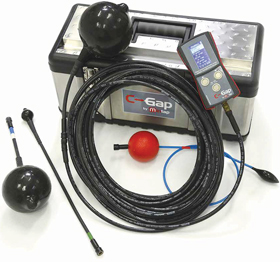

A new closed side setting (CSS) measurement device – the C-Gap – is now available to the South African market through Control Systems Rustenburg and Steelpoort. The C-Gap offers accuracy, safety and reliability to the quarrying and mining industries for the measurement of the CSS in gyratory, jaw and cone crushers.
Mintap was established by Perth-based metallurgist, Brant Tapley, and a European crusher vendor while conducting an audit at an iron ore mine in Norway. After spending countless hours at mine sites trying to optimise crusher performance and explaining the need to measure the CSS of primary crushers accurately to management, Brant said that seeing the C-Gap placed on a smoko table far from home was a ‘eureka’ moment.
Mintap has secured the distribution rights to the C-Gap and obtained Australian RCM certification. To cater for most crusher installations, the system can measure the CSS between 7 and 220 mm with an accuracy of 1 mm. The swivelled hoses connecting the sensors to the portable dustproof handheld unit are offered in lengths from 5 to 30 m, enabling users to remain well clear of the crusher, without needing to lean over any handrails.
The C-Gap works by placing selected high-density rubber hollow bulbs into the crusher mantle. When the bulb is squeezed between the fixed and moving plates, the air pressure in the hose increases, then, by correlating the air pressure through manual calibration, the CSS is measured.
The process of measuring the CSS on all four sides of a cone crusher takes less than five minutes and requires only one operator. Jaw and gyratory crushers are about the same.
The C-Gap effectively replaces current methods of CSS measurement, namely the use of lead weights, steel drums, aluminium or clay balls, or manual measurement. Because the procedure is so quick and easy, the CSS can be measured every shift on all crushers, ensuring consistent crusher operation by achieving targeted set points across all crews.
Maintaining the CSS
To date, there has not been a quick, accurate and safe way to measure the CSS in larger primary crushers; the CSS on these crushers is usually measured during shutdowns only, meaning it runs unchecked for potentially weeks at a time. This results in reduced crusher performance, placing increased emphasis on downstream circuits.
By measuring every shift, the CSS can be maintained and mantle wear can be documented, assisting with service planning. Operators on sites using the C-Gap commended its ‘safety advantage’ over the lead weights. Through site comparative trials they noted the C-Gap had an improved accuracy over the use of traditional means. The C-Gap is available for outright purchase or 12-month hire-purchase. Cost-benefit analyses of sites that currently use lead weights have shown a payback within six months of purchase, when one considers the cost and safe disposal of these. Sites that do not use lead weights enjoy the improved accuracy of the C-Gap.

© Technews Publishing (Pty) Ltd | All Rights Reserved